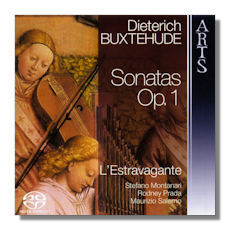
The Internet's Premier Classical Music Source
Related Links
- Buxtehude Reviews
- Latest Reviews
- More Reviews
-
By Composer
-
Collections
DVD & Blu-ray
Books
Concert Reviews
Articles/Interviews
Software
Audio
Search Amazon
Recommended Links
Site News
 SACD Review
SACD Review
Dietrich Buxtehude

Sonatas for Violin, Viola da Gamba and Cembalo, Op. 1
- Sonata I in F Major, BuxWV 252
- Sonata II in G Major, BuxWV 253
- Sonata III in A minor, BuxWV 254
- Sonata IV in B Flat Major, BuxWV 255
- Sonata V in C Major, BuxWV 256
- Sonata VI in D minor, BuxWV 257
- Sonata VII in E minor, BuxWV 258
L'Estravagante
(Stefano Montanari, violin
Rodney Prada, viola da gamba
Maurizio Salerno, harpsichord)
Arts 47731-8 Hybrid Multichannel SACD 60:30
Today, Dieterich Buxtehude probably is most famous for being the composer whom the young Johann Sebastian Bach walked twenty miles to hear. Buxtehude (1637-1707) was held in the highest regard in the latter part of the 1600s, primarily as an organist. He was born in Denmark but spent most of his career in the coastal city of Lübeck, where he wrote not only for the Protestant church (organ music, cantatas, and the like), but also for secular occasions.
In the 1690s, Buxtehude published two collections of sonatas for violin, viola da gamba, and harpsichord. The first is presented here. He may have played them himself with colleagues Johann Adam Reinken (or "Reincken") and Johann Theile. The sonatas probably were played privately, but also may have been used in St. Mary's (where the composer had been appointed organist in 1668) on feast days, or during communion. The collection, published at the composer's own expense, was dedicated to the mayor and senators of Lübeck – Buxtehude's long-time employers.
Stylistically, Buxtehude's sonatas display both his mastery of counterpoint, and of what was then known as the "stylus phantasticus" – a free, fantasia-like, quasi-improvisational style unfettered by compositional rules and restrictions. Buxtehude's synthesis of these two styles is seamless, however, and the sonatas are both expressive and learned – satisfying to the head and the heart.
There's an attractive collection of these works on Naxos with Baroque specialists John Holloway (violin), Jaap ter Linden (viola da gamba), and Lars Ulrik Mortensen (harpsichord). Arts's pricier release offers this music in the SACD format, however, and in warm, spontaneous performances by the three musicians of L'Estravagante, who generally are a little more leisurely than the aforementioned group. L'Estravagante's playing wears well, and I played this disc many times in a row without getting tired of either the music or the musicianship.
Copyright © 2008, Raymond Tuttle


















